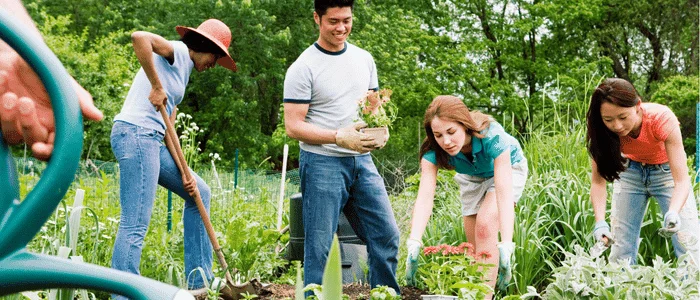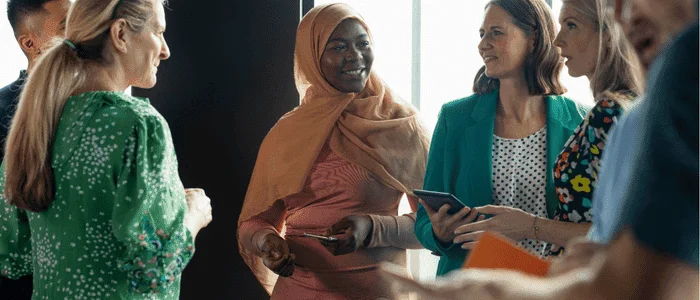

In every community, there are people who recognize challenges and take action, turning ideas into impactful initiatives. These are the stories of ordinary individuals and groups who saw a need and chose to be part of the solution. Each example showcases how community engagement can lead to meaningful change, demonstrating that when people come together, they can overcome obstacles and make a real difference. Let’s explore these nine inspiring examples of community engagement and discover how collective effort can transform lives and communities.

This inspiring story revolves around Lakshman Singh, a farmer from Rajasthan, India, who took it upon himself to solve the severe water crisis in his region. Lakshman was motivated by the desperation of his fellow villagers who struggled with water scarcity year after year.
The villagers faced an ongoing drought that made agriculture almost impossible. The lack of water threatened their livelihoods and the very existence of their community.
Lakshman and his team initiated a massive water harvesting project, digging channels, ponds, and creating a network of water reservoirs that captured and stored rainwater. They used traditional knowledge and modern techniques to revitalize the groundwater.
This initiative led to the recharging of groundwater levels, allowing the village to thrive even during the long dry seasons. Crop yields improved, and the overall quality of life in the village increased dramatically.
The project faced numerous challenges, including initial skepticism from the community and financial constraints. However, through persistent community engagement and determination, they were able to overcome these obstacles.
This project showcases the power of community-led initiatives in solving environmental issues. It teaches us that with dedication and collaboration, even the most daunting challenges can be overcome.
You can learn more about similar initiatives and support water conservation projects by visiting WaterAid’s campaign.
The #1 to make money online with TikTok Search (FREE TRAINING)

The Smith family decided to turn their daughter’s birthday into a life-saving event. Instead of the usual celebrations, they organized a community blood drive inspired by the understanding that one donation can save up to three lives.
The local blood bank was facing a severe shortage, which was exacerbated by the ongoing pandemic. The community was unaware of the critical need for blood donations.
The Smiths rallied their community, reaching out to neighbors, friends, and local organizations to participate in the blood drive. They partnered with the local Red Cross, ensuring that the event was well-organized and safe.
The drive was a huge success, collecting over 100 pints of blood. The event also raised awareness about the importance of regular blood donations, leading to more frequent drives in the area.
Convincing people to participate during a pandemic was a major hurdle, but with proper precautions and clear communication, the community’s fears were alleviated.
This example shows that turning ordinary events into extraordinary opportunities for community engagement can have a profound impact. It encourages us to think creatively about how we can contribute to our communities in meaningful ways.
To learn more and find blood donation drives near you, visit the American Red Cross to get involved.

Started by Australian sailor Ian Kiernan, Cleanup the World is a global initiative that has inspired millions of people across 130 countries to take part in local environmental cleanups.
Pollution and waste were damaging natural landscapes and oceans, with harmful effects on wildlife and communities.
Ian Kiernan organized the first cleanup event in Sydney, Australia, which quickly grew into a worldwide movement. The initiative encourages communities to organize cleanups in their local areas, focusing on removing litter, recycling waste, and raising environmental awareness.
Since its inception, Cleanup the World has mobilized millions of volunteers, removing tons of waste from the environment and fostering a global culture of environmental stewardship.
This example illustrates the power of grassroots movements in addressing global issues through local action.
Get involved in a cleanup event near you by visiting Cleanup the World.
The Trevor Project is a leading organization providing crisis intervention and suicide prevention services to LGBTQ+ youth in the United States.
LGBTQ+ youth face higher risks of mental health challenges, including suicide, due to stigma, discrimination, and lack of support.
The Trevor Project offers a 24/7 crisis hotline, text, and chat services, along with educational resources and advocacy initiatives to create a safer, more inclusive world for LGBTQ+ youth.
The organization has saved countless lives by providing critical support to LGBTQ+ youth in crisis and continues to expand its reach through awareness campaigns and partnerships.
This example highlights the importance of specialized support services in addressing the unique challenges faced by vulnerable communities.
Support the Trevor Project by donating or getting involved at The Trevor Project.

Habitat for Humanity is a nonprofit organization that helps families build and improve places to call home. Founded in 1976 by Millard and Linda Fuller, the organization has grown into a global movement with the mission of providing safe, affordable housing to those in need.
Many families around the world live in substandard housing, facing challenges that affect their safety, health, and economic stability. The lack of affordable housing is a critical issue that exacerbates poverty and limits opportunities for families to thrive. Habitat for Humanity was created to address this pressing need by empowering communities to build their own homes and improve their living conditions.
Habitat for Humanity partners with communities to build, repair, and renovate homes, providing families with the opportunity to achieve homeownership and improve their living conditions. The organization works with volunteers and donations to reduce construction costs, making homeownership more accessible to low-income families. Habitat also provides financial education and support to help families maintain their homes and achieve long-term stability.
The organization has built and improved more than 22 million homes globally, transforming the lives of families and strengthening communities. Habitat’s work has led to increased stability, security, and economic opportunities for millions of people. In addition to housing, the organization’s efforts have also contributed to community development, including improved infrastructure, access to education, and better health outcomes.
Habitat for Humanity faces the ongoing challenge of securing enough funding, materials, and volunteers to meet the growing demand for affordable housing. Additionally, the organization must navigate complex legal and regulatory environments in different countries. Despite these challenges, Habitat continues to innovate and adapt, ensuring its mission remains impactful and sustainable.
This example demonstrates how access to safe and affordable housing can have a profound impact on the well-being of families and the stability of communities. It also highlights the importance of partnerships and community involvement in creating lasting change.
Learn how you can volunteer or donate to support Habitat for Humanity at Habitat for Humanity.
The #1 to make money online with TikTok Search (FREE TRAINING)

Highlighting the Heroes:
Project Linus is a nonprofit organization that provides handmade blankets to children who are ill, traumatized, or otherwise in need of comfort. The organization was founded in 1995 by Karen Loucks, inspired by a story she read about a child undergoing chemotherapy who found comfort in a blanket.
The Challenge:
Children facing serious illnesses or traumatic situations often need comfort and security, which can be difficult to find during tough times. The emotional toll on these children and their families can be overwhelming, and something as simple as a blanket can provide much-needed solace.
The Response:
Volunteers across the United States create handmade blankets and donate them to hospitals, shelters, and social service agencies to provide warmth and comfort to children in need. The blankets are made with love and care, symbolizing the support and compassion of the broader community. Project Linus has chapters in all 50 states, each led by dedicated volunteers who organize blanket-making events and distribute blankets to local organizations.
Impact and Outcomes:
Since its founding, Project Linus has delivered millions of blankets to children, offering a tangible source of comfort and love during difficult times. The impact of the organization goes beyond the physical warmth provided by the blankets; it also fosters a sense of connection and care, showing children and their families that they are not alone.
Challenges Overcome:
One of the challenges Project Linus has faced is ensuring a consistent supply of blankets to meet the demand, especially during times of crisis or increased need. The organization has addressed this by expanding its network of volunteers and organizing large-scale events, such as Make a Blanket Day, to encourage community participation.
Key Takeaways:
This example shows how simple acts of kindness can make a significant difference in the lives of those who are vulnerable and in need of support. It also highlights the power of community and volunteerism in creating positive change.
Campaign Link:
Get involved by donating, volunteering, or making blankets for Project Linus.
Black Lives Matter (BLM) is a global movement that advocates for racial justice, equality, and an end to violence and systemic racism against Black people. Founded in 2013 by Alicia Garza, Patrisse Cullors, and Opal Tometi, BLM began as a response to the acquittal of Trayvon Martin’s killer and has since grown into a powerful force for social change.
Systemic racism and police violence have disproportionately affected Black communities, leading to widespread calls for justice and reform. The movement’s founders recognized the need for a sustained, organized effort to address these deep-rooted issues and to bring attention to the experiences of Black individuals who have been marginalized and oppressed.
BLM organizes protests, campaigns, and educational initiatives to raise awareness, demand accountability, and promote policy changes that address racial injustice. The movement also focuses on community building, creating spaces for Black people to come together, share their experiences, and support one another. BLM’s advocacy has led to increased visibility for issues of racial inequality and has sparked conversations and actions around the world.
The movement has sparked global conversations about race and justice, leading to policy changes, increased awareness, and a renewed focus on civil rights. BLM has also inspired other movements and organizations to address systemic inequality in various forms, from economic injustice to LGBTQ+ rights.
BLM has faced significant opposition and criticism, particularly from those who seek to maintain the status quo or who misunderstand the movement’s goals. Despite this, BLM has remained resilient, continuing to advocate for justice and equality in the face of adversity. The movement has also had to navigate the complexities of being a decentralized organization, with different chapters and leaders working independently toward common goals.
This example emphasizes the power of collective action in challenging systemic injustices and advocating for meaningful change. It also highlights the importance of persistence and resilience in the face of opposition.
Learn more and support the movement by visiting Black Lives Matter.

Charity: Water is a nonprofit organization that brings clean and safe drinking water to people in developing countries. Founded by Scott Harrison in 2006, the organization was born out of Harrison’s desire to find a deeper purpose after years of working in the nightclub industry.
Over 700 million people worldwide lack access to clean water, leading to health crises, poverty, and hindered development. The lack of clean water affects every aspect of life, from health and education to economic opportunities. Women and children are particularly impacted, as they often bear the burden of collecting water, sometimes walking miles each day to reach the nearest source.
Charity: Water funds sustainable water projects in remote communities, providing wells, filtration systems, and sanitation education to ensure long-term access to clean water. The organization works closely with local partners to implement projects that are tailored to the specific needs of each community. Charity: Water is also committed to transparency, using 100% of public donations to fund water projects and providing donors with detailed reports on how their contributions are being used.
The organization has funded more than 91,000 water projects, bringing clean water to over 14 million people and transforming communities through improved health and economic opportunities. Access to clean water has led to a decrease in waterborne diseases, improved school attendance (particularly for girls), and increased productivity and income for families.
One of the challenges Charity: Water has faced is ensuring the long-term sustainability of its projects. To address this, the organization has developed rigorous monitoring and evaluation processes, working with local partners to maintain and repair water systems as needed. Charity: Water also focuses on community involvement and education, ensuring that local residents have the knowledge and skills to manage their water resources effectively.
This example illustrates the life-changing impact that access to clean water can have on individuals and communities, particularly in developing regions. It also highlights the importance of transparency and accountability in nonprofit work.
Support Charity: Water by donating or starting a fundraising campaign at Charity: Water.
Movember is a global movement that raises awareness and funds for men’s health issues, including prostate cancer, testicular cancer, mental health, and suicide prevention. The movement was founded in 2003 by Travis Garone and Luke Slattery, who initially started it as a fun challenge to bring back the mustache as a fashion statement.
Men’s health issues, particularly mental health and cancer, are often overlooked, leading to preventable deaths and suffering. Many men are reluctant to seek help or discuss their health concerns due to social stigma and cultural expectations. Movember was created to break down these barriers and encourage men to take charge of their health.
Each November, men around the world grow mustaches to raise awareness and funds for men’s health initiatives. Movember also funds research and programs aimed at improving men’s health outcomes, including early detection, treatment, and mental health support. The movement has grown into a global phenomenon, with millions of participants each year.
Movember has funded over 1,250 projects worldwide, making a significant impact on men’s health by raising awareness and supporting groundbreaking research and programs. The movement has also helped reduce the stigma surrounding men’s health issues, encouraging more men to seek help and take proactive steps to protect their well-being.
One of the challenges Movember has faced is maintaining participant engagement beyond the month of November. To address this, the organization has expanded its activities and campaigns throughout the year, focusing on different aspects of men’s health and providing ongoing support and resources.
This example shows how creative and inclusive campaigns can engage people in important health issues, fostering a culture of support and awareness. It also highlights the role of humor and community in addressing serious topics.
Get involved in the Movember movement by donating or participating at Movember.
These examples of community engagement demonstrate how individuals and groups can come together to create meaningful change. Whether through local initiatives or global movements, these efforts show the power of community-driven action in making the world a better place. Let these stories inspire you to get involved in your own community and be part of the change.
Reflect on how these examples could be applied in your own community. If you feel inspired, take the first step by volunteering, donating, or simply spreading the word about these impactful initiatives. Together, we can make a difference.





